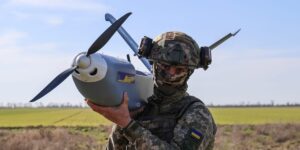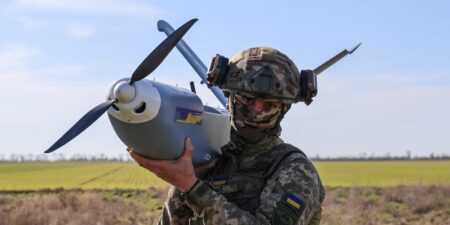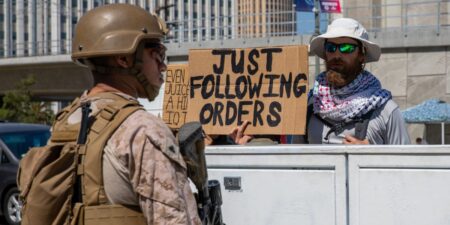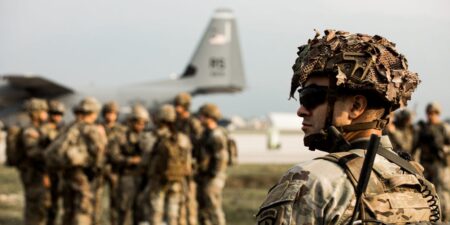This is as-told-to essay is based on a conversation with Serhii Nazarenko, a 31-year-old Kyiv resident who taught ballroom dancing for 11 years before the war. He is now an officer and machine gunner of the NGU’s elite Omega group.
The conversation has been edited for length and clarity.
I was wide awake when I lost my leg. We were in Luhansk, and my squad was ordered to assault a Russian position in the treelines.
All I could see was the soil flying as I toppled over. Then I remember seeing my commander frozen, shock in his eyes, as I lay on the ground.
Three seconds later, he started shouting. I’d stepped on a land mine.
“Apply your tourniquet on your leg,” he yelled. Emotionless, I dug my tourniquet out of my vest and tied it around my right leg.
Or what was left of it. By the time we retreated and I was evacuated to the hospital, I knew that almost everything below my right knee was gone.
We were incredibly lucky. Everyone else in my squad was safe and with no injuries, and we returned home that day.
I’ve been part of the Ukrainian National Guard’s Omega group since early 2024. As special forces, we’re deployed to assist different brigades along the front lines, conducting rescue missions, reconnaissance, and raids.
As a machine gunner, my job was to provide suppressive fire and sometimes lead portions of an assault with light machine guns such as the Soviet PKM or NATO-standard M240.
That was until October, when I was sent back to Kyiv, my hometown, to recover from my leg injury.
Before I fought the Russians, I danced
I never thought I’d join the military. Before Russia invaded in 2022, I was a sales relations manager for a customer service company headquartered in Arizona.
While working full-time, I also taught ballroom dancing — a craft I’d been pursuing since my mother took me for lessons when I was 12.
For over 10 years, I performed onstage and trained students at a dance school in Kyiv. In 2021, I was also a choreographer for the Ukrainian version of “Dancing with the Stars.”
When Russia invaded my country in 2022, I joined Ukraine’s National Guard. Our first mission was to defend Hostomel as Russian paratroopers tried to take the airfields, though I was at the rear because I was new.
Then, we were assigned to attack the infamous Russian column of armored vehicles stuck on the road to Kyiv.
After the Russians retreated, I was mostly sent to patrol areas that Ukraine had already retaken, keeping the peace in cities under our control.
I felt like I could do more. I kept thinking that I hadn’t done my job for my country yet, so I applied to Omega.
The process to join took several weeks. I had to apply through a Google Form, participate in an interview, and take a physical test.
Fighting in Ukraine’s special forces
Omega accepts members from many walks of life, but it is selective. The most important skill they looked for was my capacity to learn quickly. I had some combat experience, but I had to be proficient in various weapons beyond my standard-issue assault rifle, such as machine guns and grenade launchers.
I spent about six weeks training with Omega and integrating into my unit. You can train for as long as you like, but the real combat situation is when you show your real ability to fight. Your best test is the front line.
A key part of being an Omega member is being able to adapt. Each day, you’re learning new information about your equipment, about weapons, about tactics, about strategy, about drones, about reconnaissance.
My deployments with Omega were different from my time protecting cities in the rear. We rotated with other Omega soldiers on the front line, often fighting in close contact with the enemy, like clearing multistory apartment buildings, floor by floor, in Zaporizhzhia.
War is nothing like in video games or Hollywood. It’s messy. Out of all my missions, one left the deepest impact. We were sent to help the crew of an armored vehicle that came under Russian mortar fire. Even though we warned them to wait for us, they got out of their vehicle to repair it, and a mortar round struck them.
One of them died, and we were forced to change our mission to focus on evacuating the wounded.
We see every day how warfare is changing. Even though I’m in the special forces, not everything depends on your skill. When a drone comes to attack you, you hide. It doesn’t matter who you are — the drone or mortar just hits you, and that’s it.
The biggest pressure in Omega is to be reliable for your teammates, so we all know we can depend on each other. When I stepped on the land mine and lost my leg, my first thought was: “I’m the bad person because I didn’t do my job. Now we have to go back because of me.”
Returning to the war after losing a leg
After October, I was given a prosthetic leg, and now I’ve been back at my unit for the last three weeks.
So far, I’m helping out with public events and other tasks away from combat, while waiting for my sports prosthetic so that I can start training to run again and hopefully fight one day.
When the war is over, we’ll need to rebuild Ukraine’s cultural scene. So many of our dancers and artists have died. Losing my leg will severely hurt my dancing ability, because although I have a prosthetic leg, I’ve lost my right foot.
Still, if given a choice, I’d do it all again: Joining the National Guard in 2022 and then Omega in 2024. I know why I’m doing my job, for my family and homeland; I have a wife and a five-year-old daughter in Kyiv.
For now, we can’t think about dancing when our country’s children are dying. But I want to return to the ballroom when the fighting is done.
At least, I’ll try. People will probably be able to tell that I’m wearing prosthetics, but I still want to perform. Hopefully, it will be a beautiful dance.
Read the full article here
















